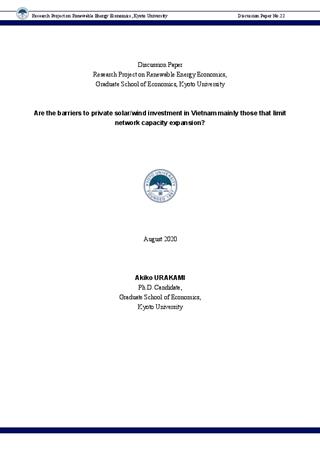TOP > ディスカッションペーパー > No.22 Are the barriers to private solar/wind investment in Vietnam mainly those that limit network capacity expansion?
No.22 Are the barriers to private solar/wind investment in Vietnam mainly those that limit network capacity expansion?
2020/8/19
Akiko URAKAMI
Ph.D. Candidate, Graduate School of Economics, Kyoto University
 Vietnam has relied on coal-fired plants as primary baseload power and keeps growing its electricity demand towards 2030. Meanwhile, Vietnam is abundant in renewable energy (RE). Through the solar FIT issued in 2017, solar power projects (approximately 4.5GW) were connected with the grid by the Commercial Operation Date (COD) (30 June 2019). However, connecting large-scale solar power plants in the southern coastal provinces has led to a curtailment in the grid intermittently. Vietnam Electricity (EVN) has expanded 220-500kV transmission lines and substations in the domestic power system to deliver solar power generated in the congested areas in 2020-21. Besides, Vietnam has been reaching its legal public debt constraint. It is difficult for EVN to depend on the Government of Vietnam (GoV) and borrow from local commercial/ international development banks, requiring the government guarantee. Thus, private investment is inevitable to meet electricity demand.
Vietnam has relied on coal-fired plants as primary baseload power and keeps growing its electricity demand towards 2030. Meanwhile, Vietnam is abundant in renewable energy (RE). Through the solar FIT issued in 2017, solar power projects (approximately 4.5GW) were connected with the grid by the Commercial Operation Date (COD) (30 June 2019). However, connecting large-scale solar power plants in the southern coastal provinces has led to a curtailment in the grid intermittently. Vietnam Electricity (EVN) has expanded 220-500kV transmission lines and substations in the domestic power system to deliver solar power generated in the congested areas in 2020-21. Besides, Vietnam has been reaching its legal public debt constraint. It is difficult for EVN to depend on the Government of Vietnam (GoV) and borrow from local commercial/ international development banks, requiring the government guarantee. Thus, private investment is inevitable to meet electricity demand.
This study aims to discuss whether the main barrier is the network side instead of the generation side and how GoV could reduce the network bottleneck to promote solar/wind power private investment. First, the author identified barriers and broadly categorized into 1) policy, 2) financial, 3) technical, 4) institutional, and 5) social/environmental aspects through the literature review and developed questionnaire. Secondly, the author conducted semi-structured interviews with 41 (investors and stakeholders) in Vietnam and neighboring countries from August to December 2019.
The main findings are as follows: weak grid capacity has become a critical barrier in solar power projects’ congested areas. When the owners made investment decisions for their projects in 2017-18, they could not realize the curtailment’s possibility in the approval process. After connecting the grid, some owners have suffered from the curtailment. If GoV, EVN, and provincial authorities had managed the capacity of each local grid transparently, controlled to give licenses to investors in the approval process carefully, or pushed some licenses to different provinces where capacity constraints are less severe, investors could have contributed to distributing the additional capacity before the COD. As the Electricity Law does not allow private firms to invest in the grid, RE owners need to wait for the GoV and EVN to upgrade the grid in some means or for a law that allows private investment. Thus, weak grid capacity, the network side issues must be a more critical barrier than that of the generation side for investors. Because of Vietnam’s legal public debt constraints, private sector involvement in transmission grids is necessary. The BOT contracts between EVN and the private sector could be possible because EVN has already experienced the BOT contracts for power plants. Also, non-sovereign finance provided by international financial institutes and development banks might be a possible option.
Keywords:renewable energy, private investment, barriers, transmission, Vietnam
本DPはMDPI “Sustainability”誌に掲載されました。
Open Accessのため、以下リンクより、無料で本文を購読、pdfをダウンロードして頂くことが可能です。
https://www.mdpi.com/2071-1050/15/13/10734
【注】なお、本論文は2023年3月に実施した現地調査の結果、その後のベトナムの政策の進捗も踏まえ、全体的に大幅な加筆修正を行い、結論、要約(アブストラクト)も修正されています。

